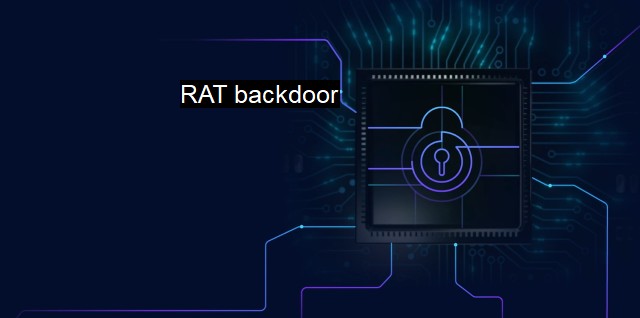What is RAT backdoor?
The Dangers of RAT Backdoor Attacks in Cybersecurity: Exploring the Usage, Impact, and Prevention Measures
A Remote Access Trojan (RAT) backdoor is a type of malware that creates a backdoor in a system, granting the attacker remote administrative control over the victim's machine. In the context of cybersecurity and antivirus protection, understanding how RAT backdoors operate and the risks they pose is crucial to robust defence against cyber threats.At its fundamental level, a RAT backdoor is a piece of software that has been designed to stay hidden from view in a system. In fact, the most vibrant embodiment of a "Trojan Horse", like its eponymous wooden horse of Greek mythology, this malware exhibits a deceptive appearance to obscure its illicit purpose, often found disguised as a legitimate or harmless software to trick the user into unwittingly installing it. This factor sets it apart from other threats like viruses which generally give away their presence by causing significant system disruption.
Once installed, a RAT backdoor can unfurl a wide field of devastation. The attacker, sitting at a remote location, gains control over the machine and can execute a plethora of offensive activities. These can range from pilfering sensitive personal or corporate data, logging keyboards to discover passwords, spying on the user by commandeering the webcam or microphone to launching DDoS attacks against other networks. A RAT backdoor exemplifies the potent integration of invisibility and control, letting the attackers into the deepest resources of its victims, interweaving themselves into their digital life.
In terms of composition, RAT backdoors come with an insidious toolkit comprised of the client software, installed on the attacker’s machine, and the server software, installed on the victim’s machine. The invisible bridge between these two is established through internet protocols. Innovative methods, such as adjourning behind valid network traffic, are also used to avoid detection.
The emergence of RAT backdoors can be ascribed to the evolving landscape of cyber threats corresponding with the ascent of interconnectivity and the Internet of Things (IoT). The amplification of connected devices has created a fertile landscape for this family of malware to procreate and proliferate.
When it comes to protecting systems from RAT backdoors, the role of antivirus and cybersecurity measures becomes pivotal. Antivirus software stands as the first line of defence, equipped with mechanisms to detect and remove known and potential threats. The attributes of a RAT backdoor make it particularly elusive to common detection methods. This invokes the need for advanced threat detection and response capabilities for discerning anomalous behaviour. The cybersecurity strategy needs to manifest a balance of both preventive and reactive measures like user risk education, regular patching, updates to software, firewalls, intrusion detection systems and rapid response to incursions.
On top of employing comprehensive antivirus and cybersecurity measures, robust monitoring can help in detecting RAT backdoor attacks. Being wary of unsolicited emails or attachments, ensuring safe browsing practices and avoiding suspicious software downloads are wise user-precautions.
To sum up, a RAT backdoor is a virulent incarnation of cyber threats, waging wars on multiple fronts – from data privacy to equipment security to integrated systems. As pawns are changed into unwitting spies and silent shadows silently manipulate, cybersecurity professionals and antivirus manufacturers face the intricate challenge of detecting and repelling these ingenious threats, the RAT backdoors, refining their protective measures and staying updated with evolving cyber threats. Staying vigilant and maintaining an effective defence system are key to winning this digital battle.

RAT backdoor FAQs
What is a Rat Backdoor?
A Rat Backdoor is a malicious software that enables remote access to a compromised computer system. Attackers use this type of malware to gain unauthorized access to a victim's computer, steal sensitive data, or distribute spam emails.How does a Rat Backdoor get into a computer system?
A Rat Backdoor can enter a computer system through several ways, including phishing emails, malvertising, and social engineering tactics. It can also be downloaded from malicious websites or bundled with other software programs.How can I protect my computer system from a Rat Backdoor?
You can protect your computer system from a Rat Backdoor by installing and regularly updating a reputable antivirus software. You should also avoid clicking on suspicious links or downloading attachments from unknown sources. Finally, practice safe internet habits like using strong passwords, enable two-factor authentication, and keep your operating system and applications up to date.What should I do if I suspect that my computer system has been compromised by a Rat Backdoor?
If you suspect that your computer system has been compromised by a Rat Backdoor, the first thing you should do is to disconnect it from the internet to prevent further damage. Then, run a full system scan using your antivirus software to detect and remove the malware. If you are unable to remove the Rat Backdoor, seek the assistance of an IT professional. Finally, change all your passwords and monitor your bank accounts and other sensitive information for unusual activities.| | A | | | B | | | C | | | D | | | E | | | F | | | G | | | H | | | I | | | J | | | K | | | L | | | M | |
| | N | | | O | | | P | | | Q | | | R | | | S | | | T | | | U | | | V | | | W | | | X | | | Y | | | Z | |
| | 1 | | | 2 | | | 3 | | | 4 | | | 7 | | | 8 | | |||||||